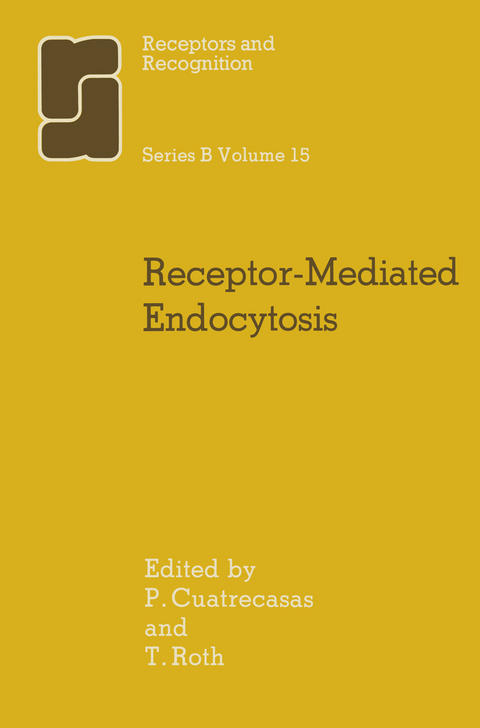
Receptor-Mediated Endocytosis
Seiten
1983
Chapman and Hall (Verlag)
978-0-412-24820-7 (ISBN)
Chapman and Hall (Verlag)
978-0-412-24820-7 (ISBN)
- Titel z.Zt. nicht lieferbar
- Versandkostenfrei innerhalb Deutschlands
- Auch auf Rechnung
- Verfügbarkeit in der Filiale vor Ort prüfen
- Artikel merken
This volume focuses exclusively on those endocytic processes that sequester proteins by a selective, receptor-mediated mechanism. The hallmarks of ,this process are the specific receptors, coated pits, coated vesicles and an ordered sequence of transit events leading to delivery to selected locations.
This volume focuses exclusively on those endocytic processes that sequester proteins by a selective, receptor-mediated mechanism. In such an endocytic process, cell surface receptors specifically bind protein ligands and localize them to specialized invaginations of the plasma membrane. These regions are coated pits, so named because they are lined on the cytoplasmic face with an ordered array of the protein, clathrin. It is this 'coat' which provides their characteristic electron microscopic image. Subsequently, these regions pinch off to form coated vesicles which rapidly lose their 'coat' and then fuse with other organelles or the plasma membrane. The hallmarks of ,this process are the specific receptors, coated pits, coated vesicles and an ordered sequence of transit events leading to delivery to selected locations. Receptor recognition, specific disposition of the endocytosed ligand and the existence of recep tor-ligand complexes at highest density in coated pits define the process as selective and concentrative. This topic has received ever increasing attention during the past few years. The evolving mechanisms are especially exciting because they come at a time when the conventional views based on thermodynamic arguments suggest that proteins should not be able to cross into the cell. Receptor-mediated endocytosis, however, reconciles the view that biological membranes should be impervious to macromolecules with the evidence that certain mac romolecules do gain entrance into the cell. During the last few years this field has been stimulated by studies on the uptake and processing of low density lipoproteins (LDL) by cells.
This volume focuses exclusively on those endocytic processes that sequester proteins by a selective, receptor-mediated mechanism. In such an endocytic process, cell surface receptors specifically bind protein ligands and localize them to specialized invaginations of the plasma membrane. These regions are coated pits, so named because they are lined on the cytoplasmic face with an ordered array of the protein, clathrin. It is this 'coat' which provides their characteristic electron microscopic image. Subsequently, these regions pinch off to form coated vesicles which rapidly lose their 'coat' and then fuse with other organelles or the plasma membrane. The hallmarks of ,this process are the specific receptors, coated pits, coated vesicles and an ordered sequence of transit events leading to delivery to selected locations. Receptor recognition, specific disposition of the endocytosed ligand and the existence of recep tor-ligand complexes at highest density in coated pits define the process as selective and concentrative. This topic has received ever increasing attention during the past few years. The evolving mechanisms are especially exciting because they come at a time when the conventional views based on thermodynamic arguments suggest that proteins should not be able to cross into the cell. Receptor-mediated endocytosis, however, reconciles the view that biological membranes should be impervious to macromolecules with the evidence that certain mac romolecules do gain entrance into the cell. During the last few years this field has been stimulated by studies on the uptake and processing of low density lipoproteins (LDL) by cells.
1 Receptor-Mediated Endocytosis: General Considerations and Morphological Approaches.- 2 The Structure of Coated Vesicles.- 3 Adsorptive Pinocytosis of Epidermal Growth Factor: Studies of its Relevance to Mitogenesis.- 4 The Binding and Internalization of Nerve Growth Factor.- 5 Entry of Enveloped Viruses into Cells.- 6 Lysosomes and Mononuclear Phagocytes.- 7 Asialoglycoproteins: Hepatic Clearance and Degradation of Serum Proteins.- 8 Entry of Toxic Proteins into Cells.- 9 Maternal-Fetal Protein Transport.- 10 The Formyl Peptide Chemotactic Receptor: Cellular Processing of Peptide and Receptor.
| Erscheint lt. Verlag | 30.9.1983 |
|---|---|
| Reihe/Serie | Receptors and Recognition ; 15 | Series B |
| Zusatzinfo | X, 304 p. |
| Verlagsort | London |
| Sprache | englisch |
| Themenwelt | Medizin / Pharmazie ► Medizinische Fachgebiete ► Pharmakologie / Pharmakotherapie |
| Naturwissenschaften ► Biologie ► Genetik / Molekularbiologie | |
| Naturwissenschaften ► Biologie ► Zoologie | |
| ISBN-10 | 0-412-24820-4 / 0412248204 |
| ISBN-13 | 978-0-412-24820-7 / 9780412248207 |
| Zustand | Neuware |
| Haben Sie eine Frage zum Produkt? |
Mehr entdecken
aus dem Bereich
aus dem Bereich
Arzneimittelverzeichnis für Deutschland (einschließlich …
Buch | Hardcover (2024)
Rote Liste Service GmbH (Verlag)
109,00 €
Englisch für Apotheker und PTAs
Buch | Spiralbindung (2024)
Kohlhammer (Verlag)
32,00 €


